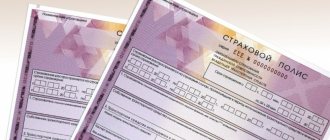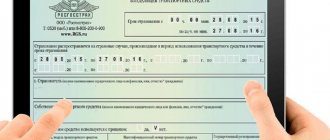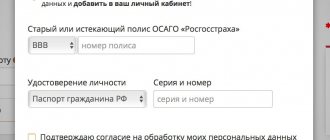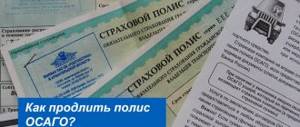What documents is the driver required to carry with him according to the law?
First of all, it should be mentioned that according to clause 2.1 of the Road Traffic Rules (hereinafter referred to as the Traffic Regulations), the driver is required to have 3 main documents with him:
- driver's license;
- a valid motor liability insurance policy;
- vehicle passport (hereinafter referred to as PTS).
At the first request of the traffic police officers, the driver is obliged to provide documents for verification. However, the difficulty in interpreting the laws lies in the fact that nowhere is it mentioned about providing copies or duplicates of the above-mentioned documents.
Article 32 of Federal Law No. 40 “On compulsory motor third-party liability insurance” regulates the mandatory availability of compulsory motor liability insurance. The lack of insurance for a motorist entails penalties in the amount of 500 rubles, based on Article 12.3 of the Code of Administrative Offenses of the Russian Federation.
How to present an electronic policy to a traffic police inspector
For a traffic police officer, both insurance policy options are completely equivalent. Uncertainties arise regarding only one issue - how to present an electronic MTPL policy to a traffic police inspector.
According to the requirements of the traffic rules, every driver, when getting behind the wheel, must have the following set of documentation with him:
- Driver license.
- Certificate of state registration of the vehicle.
- A valid MTPL policy.
Based on these requirements, a traffic police officer could legally fine a driver who does not have a paper printout of the electronic policy with him. This was regarded as a violation of Art. No. 12.3 of the Administrative Code, and was punishable by a fine of 500 rubles. If paid within 20 days, the amount was halved to 250 rubles.
not a single legislative act contained direct requirements for the mandatory translation Such contradictory rules were in effect until 2021, when legislators decided to restore order in this area.
Is it possible to drive with a copy of the MTPL policy instead of the original?
As already mentioned, no regulatory legal acts mention the possibility of providing a copy of the above documents upon request of a traffic police officer.
Important! The presence of a copy of the insurance policy does not confirm the presence of the original, even if it is notarized. Existing legal norms nowhere regulate the legal value of such documents, therefore human rights activists do not recommend using them. Even if the driver is afraid of theft or loss of documents, it is unacceptable to carry a copy of the OSAGO.
Expert opinion
Mironova Anna Sergeevna
Lawyer and lawyer for automobile law. Specializes in administrative and civil law, insurance.
When asked whether to carry a copy with you instead of the original MTPL insurance, we gave a comprehensive answer. However, in modern realities, issuing an electronic policy is popular, which causes concern among vehicle drivers.
Is a copy of electronic OSAGO legal?
Federal Law No. 40, Art. 15, clause 7.2 speaks of the possibility of purchasing electronic OSAGO (hereinafter referred to as E-OSAGO), which raises a logical question - how to provide it to a traffic police officer if necessary.
Electronic insurance is issued by contacting the insurer via the Internet. The order of registration is approximately as follows:
- The driver fills out an electronic form on the Insurance Company website and pays for the policy.
- The insurer checks the data, confirms payment and sends a copy certified by its electronic signature to the policyholder by mail.
- The IC enters data about the registered document into its database, from where the information enters the registers of the RSA and the Ministry of Internal Affairs.
- At the client's request, the insurance company sends a paper original of the document by regular mail, which the car owner can take with him.
Several years ago, on the website of the Russian Union of Auto Insurers, drivers were recommended to print out a copy of the electronic insurance and carry it with them so as not to raise questions from traffic police officers.
Today there is no such need: all traffic police and traffic police officers are equipped with the technical ability to check electronic vehicle registration in the registers of the Ministry of Internal Affairs or the RSA online, so a copy of the e-MTPL is not needed. The only thing you need is your insurance details and car registration information.
Let's summarize! Registration of an electronic policy makes it possible not to provide it at the request of traffic police officers, however, when concluding an insurance contract in paper form, the driver is required to have it.
Is it possible not to print out the electronic OSAGO policy?
The insurance can be printed after the insurance company sends it by email. To do this, the laptop or computer must be connected to the printer. The file in pdf format must be saved on your computer and then printed. There is no need to confirm its authenticity. The inspector himself checks the number against the database of motorists.
The policy does not need to be printed. Just save the file to your phone's memory. When meeting with an inspector, the document should be opened and shown to him from your smartphone.
What to do if the original document is left at home
Legislative acts do not clearly state that for driving without documents, the violator is subject to penalties. For the absence of an insurance policy, in principle, a penalty of 800 rubles is expected; for failure to provide insurance or for a photocopy, the motorist will pay 500 rubles.
Drivers need to remember that the law is the same for everyone, so it is better not to forget important documents at home.
In case of loss or theft of documents, including voluntary car insurance, you should definitely contact the insurance company again and get a duplicate.
This is done on the day of application, the driver will receive a document with the same series and number, and the form will contain the appropriate mark.
If a duplicate of the insurance policy is presented upon request, no fines are imposed, since this document is equivalent to the original.
What it is?
An electronic MTPL policy is exactly the same document from a legal point of view as a paper policy.
The possibility of obtaining electronic insurance has appeared since 2015. The main advantage of electronic MTPL is that there is no need to personally go to the insurer’s office. This significantly saves time and also makes it possible to choose absolutely any insurance company, even from those that are not represented in the region where the car owner lives. Another advantage is the impossibility of losing a document, since it is stored electronically.
The disadvantages include the fact that the time it takes for a traffic police inspector to check the policy increases, and if incorrect information is entered during registration, the policy may be invalidated.
We talked in more detail about the pros and cons of an electronic policy here, and here you will find out what this document looks like.
When can a driver drive without an insurance policy?
It is also worth mentioning that, according to Art. 2 clause 2.1 of the Traffic Regulations, the owner of the vehicle is obliged to take out civil liability insurance within 10 days.
Important! Within 10 days after purchasing a car, the owner cannot be fined for not having a civil liability policy. However, experts recommend doing this as soon as possible, since in the event of an accident the insurance amount will not be paid, and if an uninsured driver causes an accident, then all compensation costs will fall on his shoulders.
Among other things, the absence of an insurance policy will not allow the driver to register the vehicle with the traffic police.
Is a homemade printout of an MTPL policy a document?
The process of registration of compulsory motor liability insurance is described in the Regulation of the Bank of Russia dated September 19, 2014 N 431-P “On the rules of compulsory civil liability insurance of vehicle owners.” The car owner chooses one of two options for concluding a contract:
- By contacting the office of the insurance company or an insurance representative in person;
- By filling out an online application on the official website of the insurer.
In the first case, he receives a compulsory motor liability insurance policy on a special colored form that has several degrees of protection. In the second case, the insurer issues an electronic policy, e-OSAGO, sends it to the applicant’s e-mail and places it in his personal account on its website.
Since the uniform form of the policy form is fixed by Regulation N 431-P, e-OSAGO is a black and white digital copy of the policy on a color form, which the policyholder can print out independently.
That is, the legislator does not distinguish between compulsory motor liability insurance on a secure form and a printout if both documents correspond to the approved form.
Types and amounts of fines for the absence of a compulsory motor liability insurance policy
Constantly changing legislation requires clarification regarding the sanctions applied to drivers who do not have an insurance policy.
Until November 2014, if a driver was found to lack insurance, they were deprived of the opportunity to operate their vehicle. In other words, the motorist was threatened with deprivation of his license.
The types of fines and amounts are presented in the table:
| Type of fine: | Fine amount | Reference to law |
| Driving without insurance, driving with a copy of insurance, operating a car outside the validity period of compulsory motor liability insurance, the driver is not included in the policy | 500,00 | Code of Administrative Offenses of the Russian Federation, art. 12.3, part 2; Art. 12.37, part 1. |
| No insurance at all, expired policy | 800,00 | Code of Administrative Offenses of the Russian Federation Art. 12.37, part 2. |
Example: Ivanov took out an insurance policy, but for fear of losing the document, he carries with him a photocopy of the motor vehicle license. In the event of an inspection, the traffic police inspector has the right to impose penalties on the basis of the Code of Administrative Offenses of the Russian Federation, Article 12.3, Part 2 for driving without insurance in the amount of 500 rubles.
The modern Code of Administrative Offenses of the Russian Federation presupposes administrative material penalties that can be imposed repeatedly. For example, a driver fined for operating a car without insurance may be punished a second time.
How long can you drive with invalid insurance?
As Art. 12.37 part 2 of the Code of Administrative Offenses of the Russian Federation, punishment is provided both for the absence of this document and for its delay. If the driver has an expired policy, then it is considered that he does not have it and the amount of the fine will be the same as for the absence of this document, i.e. 800 rubles.
That is, an expired motor vehicle license is equivalent to its complete absence and the penalties are similar.
When should the contract be renewed?
Let's figure out how long the policyholder is obliged to carry out the procedure for prolonging his contract. Previously, it was the case that if this document expired, the driver had the right to drive his car for another 30 days.
In cases where the insurance contract has expired, the law provided for 30 days from the date of expiration of the policy for re-issuance. But this law was repealed and now the existing contract with the insurance company must be renewed no later than the day it expires. You will find important details about how long you can drive without compulsory motor liability insurance after your insurance expires here.
Based on the above, we advise you to apply for an extension of the MTPL agreement at least one day before its expiration. To extend the current contract, you must contact your insurance company, or enter into a new contract with another insurance organization.
Summarizing
The amount of the insurance premium for an MTPL policy is available to every motorist in Russia, since tariffs are regulated by legislation and strictly controlled. Every driver should have an insurance policy, as this eliminates fines, problems with paying compensation in case of an accident, as well as the need to compensate the injured party.
When purchasing an E-OSAGO policy, the driver has the right to carry a printed copy in case of unforeseen circumstances, for example, lack of Internet or other breakdowns in equipment that allows checking the availability of insurance. When concluding a paper contract, the motorist must provide the original insurance, otherwise he will be fined.
Is it possible to travel with him?
The electronic MTPL policy (or its printed copy) is a 100% legal document that is accepted by absolutely all institutions in Russia. All employees of the State Traffic Inspectorate are familiar with the procedure for checking electronic policies.
This type of policy is not only completely legitimate, but also mandatory for insurers. Since 2021, according to the law on compulsory motor insurance, all insurance companies are required to provide their clients with the e-MTPL service.
Features of the electronic policy
An electronic policy has the same legal force as a special paper form. From July 1, 2018, a new unified e-OSAGO form with the XXX series is in effect. One of the differences from the old version is the presence of a QR code. It contains information about the seller's name, policy details and date of issue, and vehicle and driver details. This code gives direct access to the RAMI (Russian Association of Auto Insurers) database.
The policyholder receives the document via email and in myAlpari as a PDF file, signed by a person authorized to provide a qualified signature to the insurance company. Along with it - a check, a European protocol form and a reminder to the client on how to print out the MTPL policy and submit it to the traffic police upon request. The driver has the right to receive a printed copy of the insurance in person at the office or at his home address, paying postage.
It is important to know! Information about the issued policy is entered by the insurance company into the automated information system managed by RAMI. Access to this database is open; any user can verify the authenticity of a document based on its series, number or QR code.
The validity period of the Policy begins no earlier than 3 days from the date of submission of the application to the Insurance Company and payment of the insurance premium. The user has the right to choose and determine the validity period of the agreement.
Advantages of an electronic policy
The undeniable convenience of electronic insurance is that a comprehensive insurance policy or compulsory motor liability insurance can be issued absolutely anywhere where there is Internet access, if you have a gadget. However, one thing is certain: you will still have to visit a car service center and undergo a technical inspection - the diagnostic card data will need to be provided when applying for an insurance policy. Although there is no difference here - this procedure is mandatory for all cars over 3 years old.
Another inconvenience for the lazy is that all data will have to be entered manually yourself, including alphanumeric sets (passport series and numbers, STS, PTS, information about the organizations that issued the passport, dates of issue, VIN code).
An undoubted advantage, however, is the ability to compare offers from different insurance companies and choose the most profitable one thanks to the built-in calculator when filling out an online declaration.
You can also pay for the policy online and then print it out - it will be no different from a paper policy. However, even if you do not print it, it is considered valid.
Therefore, from the point of view of further use, there is absolutely no difference between paper and electronic policies. The only difference is the process of writing the policy.











